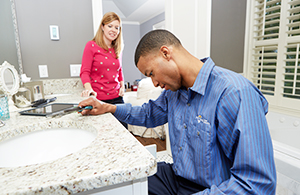Diving into Home Plumbing Basics: A Beginner's Tutorial
Diving into Home Plumbing Basics: A Beginner's Tutorial
Blog Article
Just how do you feel with regards to Plumbing basics: How your home plumbing works?

Plumbing is a vital facet of any type of home, in charge of supplying clean water for alcohol consumption, food preparation, and showering, as well as getting rid of wastewater safely. Comprehending the essentials of home plumbing is essential for each home owner to ensure appropriate maintenance, troubleshooting, and, if needed, repairs. In this beginner's guide, we'll cover the basic principles of home plumbing to help you end up being a lot more knowledgeable about exactly how it functions.
Water Heater
The water heating unit is in charge of home heating water for residential use, consisting of bathing, food preparation, and cleansing. Common types of hot water heater include tank-type water heaters, tankless (on-demand) hot water heater, and heat pump water heaters. The water heater is linked to the water supply system and provides warm water to plumbing fixtures as required.
Water drainage System
The water drainage system gets rid of wastewater from your home and lugs it away to a sewer therapy center or septic tank. It contains a network of pipelines, installations, and components that move wastewater from plumbing components to the major sewage system line or septic system. Correct water drainage is vital to protect against obstructions, back-ups, and sewer leaks.
Ventilation System
The air flow system aids keep appropriate air pressure and avoid sewer gases from entering your home. Vent pipelines, likewise referred to as vent heaps, prolong from plumbing fixtures to the roofing system, allowing sewer gases to run away securely outside. Air flow pipelines likewise enable air to enter the water drainage system, assisting in smooth wastewater flow and avoiding suction or vacuum results.
Water System System
The supply of water system brings tidy water right into your home from a community water resource or a personal well. It consists of a major water line that links to your home's plumbing system, typically situated underground. A water meter measures the quantity of water taken in, while a shut-off shutoff enables you to control the flow of water right into your home.
Plumbing Components
Plumbing fixtures are gadgets that deliver water to different parts of your home and include sinks, taps, toilets, showers, tubs, and appliances such as dish washers and washing equipments. Each fixture is attached to the water supply system by means of pipes and installations and might have its shut-off valve for upkeep or emergencies.
Typical Plumbing Devices
Having the right tools handy is important for executing basic plumbing repair services and upkeep tasks. Typical plumbing devices include adjustable wrenches, monkey wrench, pliers, pipeline cutters, hacksaws, plungers, augers (or drainpipe serpents), and Teflon tape. Having these tools easily offered can aid you deal with small plumbing concerns successfully.
Basic Plumbing Repair Work
While some plumbing repair work may call for specialist aid, several typical issues can be addressed with basic do it yourself techniques. Discovering just how to fix a leaking tap, unblock a drainpipe, replace a toilet flapper, or repair a leaking showerhead can save you money and time on plumbing fixings.
Verdict
Understanding the basics of home plumbing is vital for every single home owner to maintain a safe, functional, and effective plumbing system. By familiarizing yourself with the supply of water system, plumbing fixtures, drain system, ventilation system, common plumbing tools, and basic repair work, you can confidently deal with minor plumbing issues and ensure your home's plumbing system runs efficiently.
Understanding Basics of Home Plumbing System: A Beginner's Guide
The Main Components of Your Home Plumbing System
The Water Supply System
This system is responsible for transporting fresh water into your home. It usually has a main water line that splits into two branches: one directed towards cold water services and the other connected to a water heater for hot water. The pressure is key here; it ensures water reaches all parts of your house.
The Drainage System
Once water has been used, it becomes wastewater that needs to be removed from your home. This is where the drainage system comes into play. It includes all the pipes that carry wastewater and sewage away from your house to sewage treatment facilities or septic tanks.
The Vent System
The vent system prevents sewer gases from entering your home and helps maintain the pressure balance that allows wastewater to flow out properly. These vents usually exit through the roof of your house.
Water Heating System
For those who enjoy hot showers or using hot water for cleaning, the water heater is a crucial part of the plumbing system. It can be a tankless system, which heats water on demand, or a traditional water tank model.
Common Plumbing Problems and Basic Troubleshooting
Plumbing systems, while designed to be durable, can face issues like clogged drains, leaky faucets, or low water pressure. Here are some basic troubleshooting tips:
Clogged Drains
Use a plunger or a plumber's snake to try and dislodge whatever is blocking the drain. Regular cleaning can prevent clogs.
Leaky Faucets
Often caused by worn-out washers or gaskets, these can usually be replaced by someone with basic DIY skills.
Low Water Pressure
This might be due to sediment build-up in your fixtures or a leak somewhere in your water line. Cleaning out aerators or seeking a professional to detect leaks might be necessary.
Preventive Maintenance Tips
Maintaining your plumbing system is key to avoiding emergencies. Regularly check for leaks, avoid disposing of grease down the sink, and have your system inspected by a professional plumber at least once a year.

I'm just very enthusiastic about Plumbing Basics Every Homeowner Should Know and I hope you enjoyed reading the entire blog post. Sharing is good. Helping people is fun. I cherish your readership.
Go Company Report this page